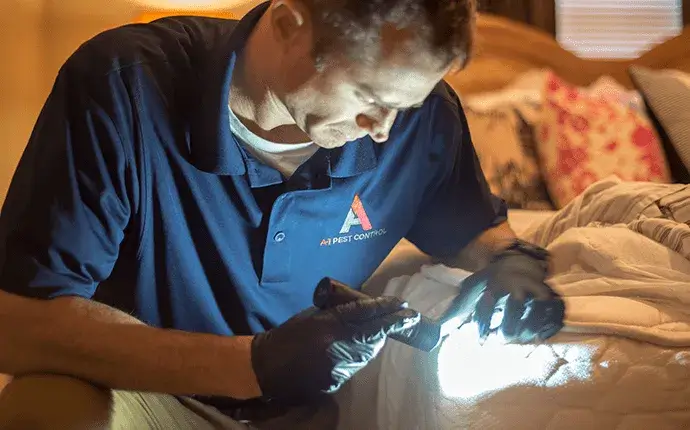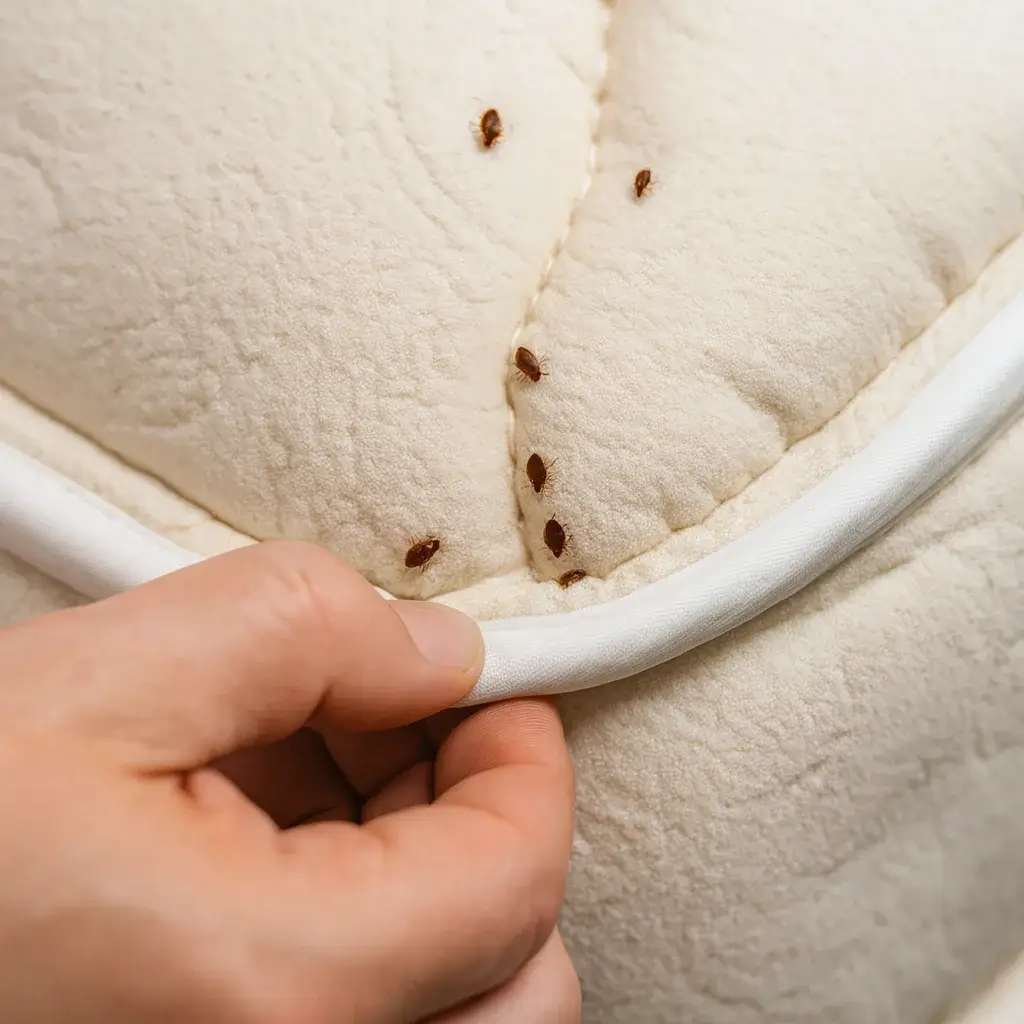
A Step-by-Step Guide to the Professional Bed Bug Extermination Process

When bed bugs invade your home or business, the experience can feel overwhelming. Bed bugs hide in mattresses, box springs, bed frames, wall voids and furniture, reproduce quickly, and can persist despite repeated attempts to kill them.
If you’re asking “how does bed bug treatment work?” or “what does the bed bug extermination process look like?” this guide explains the full bed bug pest control process from inspection through follow-up visits, and why professional bed bug treatment is the most reliable way to get rid of bed bugs for good.
Table of Contents
Why Bed Bugs Are Such Pests
Bed bugs are among the most frustrating pests because of their behavior and life cycle. Here are the main reasons they are hard to control:
Bed bugs hide extremely well.
Adult bed bugs and nymphs squeeze into tiny hiding spots: Seams of mattresses, cracks in bed frames, electrical outlets, wall voids, and inside furniture items. These hiding spots make detection difficult and allow bed bugs to survive routine cleaning.
Bed bugs reproduce quickly.
A single mated female can lay hundreds of eggs. Populations can explode from just a few hitchhiking bed bugs that arrive in luggage, furniture, or clothing.
They survive long without feeding.
Bed bugs can go months without feeding under the right conditions, which lets them survive between occupants in a room or entire home.
They spread silently.
Bed bugs spread by crawling into bags, on clothing, on used mattresses, and through wall voids in multi-unit housing. A single infested item can cause an entire building to face a bed bug infestation.
Not all treatments reach hiding spots.
Many DIY sprays and bug bombs can kill bed bugs on contact but will not reach eggs or bed bugs concealed inside wall voids or furniture joints. That’s why targeting bed bugs requires a planned treatment method led by trained technicians.

Because of these factors, professional pest control is usually necessary for successful bed bug elimination.
How a Bed Bug Infestation Starts
Most bed bug infestations begin with a small number of bed bugs or eggs introduced into a new environment. Common sources include:
Travel
Luggage, hotel rooms, and transit hubs are frequent places to pick up bed bugs. They crawl into seams and folds, then come home in your suitcase.
Secondhand Furniture
Used furniture, especially mattresses and sofas, can hide live bed bugs or eggs.
Visitors and Guests
People can unintentionally bring bed bugs into your home on clothing or personal items.
Multi-Unit Spread
In apartments and condos, bed bugs move between units through wall voids, electrical outlets, and baseboards.
Public Spaces
Laundromats, movie theaters, and libraries are lower-risk but possible places for transfer.
Early detection is crucial: a small bed bug population is far easier to treat than a large, entrenched infestation.
How Professional Bed Bug Treatment Works
Thorough inspection
Any effective bed bug control plan starts with a thorough inspection. The trained pest control technicians at A-1 perform a detailed, room-by-room search for evidence of a bed bug infestation: live bed bugs, shed skins (shed skins), fecal spots, and live bed bugs hide in seams and corners. A thorough inspection helps determine the bed bug population, life stages present (eggs, nymphs, adult bed bugs), and the best targeting bed bugs strategy.
A proper inspection identifies:
- Infested areas and hiding spots
- The severity of the bed bug infestation
- Whether wall voids, box springs, mattresses, or furniture items are involved
This step ensures the treatment method is targeted and cost effective.
Preparation
Preparation is essential to maximize the effectiveness of professional bed bug treatment and to make follow-up inspections more productive. Typical preparation steps include:
- Laundering bed sheets, bed sheets, bedding and linens in hot water and dry on high heat for a few hours when possible (high heat in dryers kills bed bugs on fabrics and is a common prep step).
- Placing personal items and smaller clothing in a sealed plastic bag or preparing them for a hot-water wash or dryer.
- Decluttering the affected area so technicians can treat other rooms and hidden surfaces.
- Removing items from drawers and closet shelves and preparing furniture for inspection.
- Vacuuming mattresses and carpets (dispose of vacuum bag in a sealed plastic bag).
Targeted Chemical Treatments
A-1 Pest Control utilizes targeted chemical treatments designed for bed bug control. These chemical treatments include products labeled for bed bug control and applied by trained technicians to cracks, crevices, bed frames, baseboards, and other hiding spots.
Non-Chemical and Mechanical Tools
In addition to chemical treatments, an integrated approach may include:
- Vacuuming to remove live bed bugs and shed skins
- Encasing mattresses and box springs with mattress encasements to trap bed bugs inside and prevent new infestations
- Bed bug interceptors under bed legs to monitor and capture crawling bed bugs (bed bug interceptors are a crucial step for monitoring and prevention)
- Removing or isolating heavily-infested furniture items when necessary
Follow-up Inspections and Follow Up Visits
Because bed bug eggs may survive initial treatment and hatch later, follow up inspections and visits are standard elements of the bed bug extermination process. Technicians schedule follow-up inspections to verify that:
- No live bed bugs remain
- Eggs did not hatch into a new bed bug population
- Additional treatments are applied to any persistent harborages
- A typical plan may include 2–3 follow up visits spaced weeks apart, depending on infestation severity.
Long-term Prevention and Monitoring
Successful bed bug elimination often requires prevention and monitoring. That might mean the use of mattress encasements and bed bug interceptors to detect future activity, regular inspections in hotels or multi-unit housing (proactive pest control), and education on how bed bugs spread and how to inspect used furniture or luggage.
Why DIY Bed Bug Treatments Often Fail
Many homeowners try DIY methods first, but these approaches often fail for several reasons:

- DIY sprays and bug bombs (bug bombs) typically only affect exposed bed bugs and rarely reach hidden bed bugs inside furniture or wall voids. Bug bombs can even scatter bed bugs into other rooms, spreading the infestation.
- Misapplied consumer products may cause bed bugs to develop resistance if used improperly; bed bugs can develop resistance to certain insecticides over time.
- Attempting to treat everything yourself without professional inspection may cause unnecessary expense, furniture disposal, and stress without ensuring complete eradication.
- DIY focus on visible bed bugs misses eggs and deeper hiding spots, which leads to re-infestation.
For severe infestations, a professional exterminator and combined treatment method is usually the only cost effective route to complete eradication.
How Long Does It Take to Get Rid of Bed Bugs After Extermination?
One of the most common customer questions is how long it takes to be rid of bed bugs. The answer varies by infestation severity and the treatment method used:
Small Infestations
With prompt professional treatment and good preparation, many small infestations can be effectively eliminated within a few weeks, often requiring two or three treatments and follow up inspections.
Severe Infestations
Large or long-established infestations (especially those that have spread to multiple rooms or wall voids) may take longer and require additional treatments and monitoring.
No Overnight Guarantees
It is rare to achieve 100% eradication overnight. Professional exterminators rarely promise complete elimination in a single visit because eggs may hatch after the initial treatment. Multiple visits ensure complete eradication and reduce re infestation risk.
In short: a successful bed bug elimination often requires a multi-step treatment process and several follow-up visits to ensure all life stages are eliminated.
How to Prepare Your House for Bed Bug Treatment
Preparation improves treatment outcomes. Here’s a concise checklist to help you get ready:
Launder bed sheets, bed sheets, pillowcases, and clothing in hot water and dry on high heat for a few hours. Place cleaned items in sealed plastic bags.
Reduce clutter so technicians can access baseboards, bed frames, and furniture.
Remove items from drawers and closet shelves. Place personal items in sealed plastic bags for inspection or laundering.
Vacuum mattresses, sofas, and carpets. Immediately discard or seal the vacuum bag.
Disassemble bed frames if possible and make beds accessible for inspection and treatment.
Follow the technician’s specific instructions about food preparation, pet containment, and occupancy during treatment.
Proper preparation is a crucial step in effective bed bug control and helps reduce the number of follow up visits required.
FAQs
Is it possible to 100% get rid of bed bugs overnight?
No reputable pest control company guarantees 100% elimination overnight. A complete eradication requires a well-executed bed bug extermination process, including targeted chemical treatments, monitoring, and follow-up inspections. Eggs can hatch after the initial treatment, so follow-up visits are standard.
How long does it take to see results after treatment?
You may see a reduction in live bed bugs within days, especially after vacuuming and the first chemical application. However, full elimination typically takes several weeks and multiple visits for follow up inspections until no activity is detected.
Can I use bug bombs to get rid of bed bugs?
Bug bombs are not effective for bed bug extermination and can drive bed bugs into wall voids and other hidden locations. Relying on bug bombs may worsen the infestation and complicate professional treatment.
Do mattress encasements help?
Yes. Mattress encasements trap bed bugs inside mattresses or prevent new bed bugs from entering. Combined with targeted chemical treatments and monitoring, mattress encasements are an effective tool in preventing re infestation.
What about diatomaceous earth?
Diatomaceous earth is a desiccant that can help reduce bed bug numbers in certain non-sensitive areas. It may be part of an integrated plan but should be used by professionals to avoid contamination of living spaces.
Will professional treatment harm my family or pets?
When applied by trained technicians following label instructions, chemical treatments used by professional pest control companies are safe. Technicians will advise about re-entry times and safety precautions for children and pets.
Contact A-1 PC For a FREE Bed Bug Inspection Today
Our bed bug pest control includes a thorough bed bug extermination process: inspection, prep, targeted chemical treatments, mechanical measures, and follow-up inspections.
If you suspect a bed bug infestation or have seen live bed bugs in your home or business, don’t wait. We service Lenoir, Mooresville, Hickory, Blowing Rock, West Jefferson, and Hendersonville and surrounding areas.
Call us today at 828-481-9140 or fill out the form below to schedule your FREE inspection and learn how our proven home pest control plans can help prevent bed bugs and other pests year-round.
Schedule Your Free Inspection
Complete the form to schedule your no obligation estimate with A-1 Pest Control.
"*" indicates required fields
